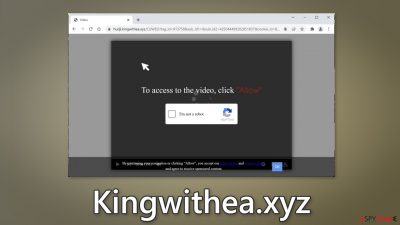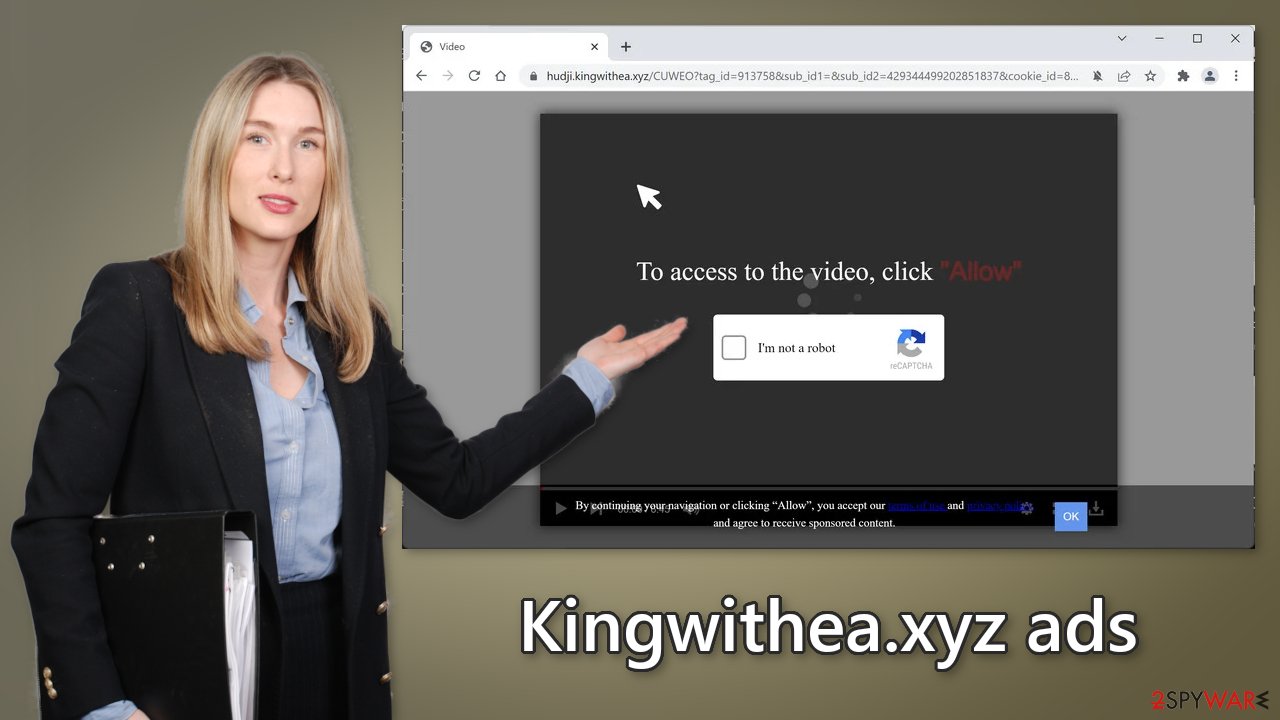Kingwithea.xyz ads (scam) - Free Instructions
Kingwithea.xyz ads Removal Guide
What is Kingwithea.xyz ads?
Kingwithea.xyz is a deceptive site trying to trick people into clicking the “Allow” button

If you are constantly bombarded with pop-up ads, you may have given permission for a page to show you push notifications. Kingwithea.xyz is a website that is capable of displaying pop-up ads even when the browser is closed. It uses social engineering methods to fool people into clicking the “Allow” button on a browser prompt.
Users may start seeing ads promoting adult, gambling, and scam sites. They may be redirected to dangerous pages that try to get their personal information, infect their machines with PUPs (potentially unwanted programs),[1] and malware. This can be done through fake software offers, updates, and other schemes.
| NAME | Kingwithea.xyz |
| TYPE | Push notification spam; adware |
| SYMPTOMS | Intrusive pop-up ads start appearing in the corner of the screen |
| DISTRIBUTION | Shady websites, misleading advertisements, bundled software |
| DANGERS | The website could be using unsafe advertising networks that place ads leading to dangerous websites |
| ELIMINATION | Go to your browser settings and disable push notifications |
| FURTHER STEPS | Use a repair tool FortectIntego to fix any remaining damage and clear your browsers |
Stop pop-up ads from appearing

First, you should know how pages, like Kingwithea.xyz are spread on the Internet. The truth is, that they can rarely be found through the search results. Most of the time, people browse through shady pages that are full of deceptive ads, and sneaky redirects.[2] You should abstain from clicking on random links and visiting unknown sites.
A place that users get redirected from quite often is illegal streaming platforms.[3] They are unregulated so they might even be filled with fake “Download” and Play” buttons. When a website like Inancukan.xyz, News-nogame.cc or Smscoldne.xyz opens, people may think that they have to click the “Allow” button to be able to access the movie or TV show they chose to watch.
In reality, these pages do not have any content to explore, except for the deceptive message and picture. A legitimate CAPTCHA[4] verification step should never ask you to choose between “Block” and “Allow” on a browser prompt. Usually, people have to identify certain objects in pictures or simply check a box.
Push notification spam pages can also appear without any user input. This can happen if you are infected by adware. It is a type of PUP that generates commercial content on the machine, like pop-ups, banners, surveys, and redirects. The developers of the program can make a profit from PPC advertising.[5]
To stop pop-up ads from appearing, we recommend going to your browser settings first and trying to disable the permission you gave Kingwithea.xyz. If that will not work, there is a possibility that adware is hiding in the background.
Google Chrome (desktop):
- Open Google Chrome browser and go to Menu > Settings.
- Scroll down and click on Advanced.
- Locate the Privacy and security section and pick Site Settings > Notifications.
![Stop notifications on Chrome PC 1 Stop notifications on Chrome PC 1]()
- Look at the Allow section and look for a suspicious URL.
- Click the three vertical dots next to it and pick Block. This should remove unwanted notifications from Google Chrome.
![Stop notifications on Chrome PC 2 Stop notifications on Chrome PC 2]()
Google Chrome (Android):
- Open Google Chrome and tap on Settings (three vertical dots).
- Select Notifications.
- Scroll down to Sites section.
- Locate the unwanted URL and toggle the button to the left (Off setting).
![Stop notifications on Chrome Android Stop notifications on Chrome Android]()
Mozilla Firefox:
- Open Mozilla Firefox and go to Menu > Options.
- Click on Privacy & Security section.
- Under Permissions, you should be able to see Notifications. Click Settings button next to it.
![Stop notifications on Mozilla Firefox 1 Stop notifications on Mozilla Firefox 1]()
- In the Settings – Notification Permissions window, click on the drop-down menu by the URL in question.
- Select Block and then click on Save Changes. This should remove unwanted notifications from Mozilla Firefox.
![Stop notifications on Mozilla Firefox 2 Stop notifications on Mozilla Firefox 2]()
Safari:
- Click on Safari > Preferences…
- Go to Websites tab and, under General, select Notifications.
- Select the web address in question, click the drop-down menu and select Deny.
![Stop notifications on Safari Stop notifications on Safari]()
MS Edge:
- Open Microsoft Edge, and click the Settings and more button (three horizontal dots) at the top-right of the window.
- Select Settings and then go to Advanced.
- Under Website permissions, pick Manage permissions and select the URL in question.
- Toggle the switch to the left to turn notifications off on Microsoft Edge.
![Stop notifications on Edge 2 Stop notifications on Edge 2]()
MS Edge (Chromium):
- Open Microsoft Edge, and go to Settings.
- Select Site permissions.
- Go to Notifications on the right.
- Under Allow, you will find the unwanted entry.
- Click on More actions and select Block.
![Stop notifications on Edge Chromium Stop notifications on Edge Chromium]()
Clear cookies and cache
The next important step is to clear your browsers. With the help of cookies, websites and web-based applications can gather data like your IP address, geolocation, websites you visit, links you click on, and things you purchase online. This is not necessarily bad. Websites can use this information to personalize the user experience. However, data can also be sold to advertising networks and other third parties.
That is why it is recommended to clear cookies and cache regularly. You can use a maintenance tool like FortectIntego for this task. It can take care of the issue automatically. This software can also fix various system errors and corrupted files which is especially helpful after a virus infection.
Remove potentially unwanted applications
As we mentioned before, the first removal step may not have been effective if you are infected by adware. If you still experience unpleasant symptoms, we urge you to check your system for PUAs. Most of the time, they sneak in through freeware distribution platforms. These websites include bundled software in the installations and hope that most people will not notice.
You should use only official web stores and developer sites for software installations. You should also always choose the “Custom” or “Advanced” installation method, read the Privacy Policy and Terms of Use. The most important step is to check the file list and untick the boxes next to any files that seem unrelated.
Fraudsters often disguise PUPs as “handy” tools so they would be more difficult to identify for the average user. You should deploy SpyHunter 5Combo Cleaner or Malwarebytes professional security software that will perform a full system scan and eliminate any PUPs automatically. They can also prevent such infections in the future by warning you about a suspicious download. If you still prefer doing it yourself, here are step-by-step instructions for Windows and macOS:
Windows 10/8:
- Enter Control Panel into Windows search box and hit Enter or click on the search result.
- Under Programs, select Uninstall a program.
![Uninstall from Windows 1 Uninstall from Windows 1]()
- From the list, find the entry of the suspicious program.
- Right-click on the application and select Uninstall.
- If User Account Control shows up, click Yes.
- Wait till uninstallation process is complete and click OK.
![Uninstall from Windows 2 Uninstall from Windows 2]()
Windows 7/XP:
- Click on Windows Start > Control Panel located on the right pane (if you are Windows XP user, click on Add/Remove Programs).
- In Control Panel, select Programs > Uninstall a program.
![Uninstall from Windows 7/XP Uninstall from Windows 7/XP]()
- Pick the unwanted application by clicking on it once.
- At the top, click Uninstall/Change.
- In the confirmation prompt, pick Yes.
- Click OK once the removal process is finished.
macOS:
- From the menu bar, select Go > Applications.
- In the Applications folder, look for all related entries.
- Click on the app and drag it to Trash (or right-click and pick Move to Trash)
![Uninstall from Mac 1 Uninstall from Mac 1]()
To fully remove an unwanted app, you need to access Application Support, LaunchAgents, and LaunchDaemons folders and delete relevant files:
- Select Go > Go to Folder.
- Enter /Library/Application Support and click Go or press Enter.
- In the Application Support folder, look for any dubious entries and then delete them.
- Now enter /Library/LaunchAgents and /Library/LaunchDaemons folders the same way and terminate all the related .plist files.
![Uninstall from Mac 2 Uninstall from Mac 2]()
How to prevent from getting adware
Stream videos without limitations, no matter where you are
There are multiple parties that could find out almost anything about you by checking your online activity. While this is highly unlikely, advertisers and tech companies are constantly tracking you online. The first step to privacy should be a secure browser that focuses on tracker reduction to a minimum.
Even if you employ a secure browser, you will not be able to access websites that are restricted due to local government laws or other reasons. In other words, you may not be able to stream Disney+ or US-based Netflix in some countries. To bypass these restrictions, you can employ a powerful Private Internet Access VPN, which provides dedicated servers for torrenting and streaming, not slowing you down in the process.
Data backups are important – recover your lost files
Ransomware is one of the biggest threats to personal data. Once it is executed on a machine, it launches a sophisticated encryption algorithm that locks all your files, although it does not destroy them. The most common misconception is that anti-malware software can return files to their previous states. This is not true, however, and data remains locked after the malicious payload is deleted.
While regular data backups are the only secure method to recover your files after a ransomware attack, tools such as Data Recovery Pro can also be effective and restore at least some of your lost data.
- ^ Chris Hoffman. PUPs Explained: What is a “Potentially Unwanted Program”?. Howtogeek. Technology Magazine.
- ^ Nick Altimore. Sneaky Redirects – What You Need To Know. Sirlinksalot. Link Building Agency.
- ^ Victor Poitevin. Illegal streaming: beware of the backlash. Stormshield. Security Monitoring.
- ^ CAPTCHA. Wikipedia, the free encyclopedia.
- ^ What Is PPC? Learn the Basics of Pay-Per-Click (PPC) Marketing. Wordstream. Advertising Solutions.













